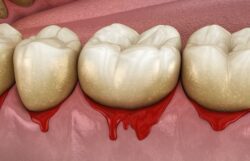Almost half of American adults suffer from an infection in the gum tissue called gum disease. This common oral health concern begins with inflammation of the gums and then deteriorates the gum tissue, teeth, and jawbone as it advances. You will need treatment from your dentist to resolve this problem because the infection will not clear up on its own.
You could suffer irreversible harm to your smile if you do not seek urgent treatment for gum disease. It is easier to treat when diagnosed early as well. But many people disregard warning signs that they have this problem in their gums, and the disease is allowed to advance this way.
Recognizing the symptoms of this infection will ensure you know when it is time to call the dentist about this serious issue in your gums. So read on to learn about four common signs that you have gum disease.

Bleeding in the Gums
Gingivitis, the early stage of gum disease, begins with irritation in the gum tissue. You may see swelling and redness as bacteria inflame the gums. But another common symptom of this infection is bleeding.
You might see gums bleed on a chronic basis when you brush your teeth and floss. A sign this is happening is if you spit into the sink after your oral hygiene regimen and see red or pink. This occurrence is abnormal, and you should talk to a dentist if this problem persists.
Soreness and Sensitivity in the Gums
Irritation from gum disease can extend beyond visible symptoms. The inflammation may cause pain in the gums. They can feel sore and tender on a chronic basis that may worsen when you floss or brush your teeth.
Oral pain of any kind is not normal and should warrant an evaluation from your dentist. Do not disregard pain in your gums, even if you think you can tolerate the discomfort. The pain will likely worsen without treatment from your dentist.
Chronic Bad Breath
When gum disease progresses, excess bacteria from the infection will begin to collect in the gum pockets. Your toothbrush and floss cannot reach these spots to clean and clear away the bacteria.
As the bacteria linger there, you will notice they emit a foul odor that will make your breath smell bad. Chronic bad breath, also known as halitosis, can mean that you have this oral infection, and it will not go away until you see your dentist.
Dental Alignment Changes
Advanced gum disease can see bacteria damaging the gums, the teeth, and the jaw. When this happens, gum tissue may recede, exposing more of the tooth’s surface. Not only will this affect the way your smile looks, but it also increases your risk of cavities and other dental problems.
The teeth may also start to feel loose and wiggly in their sockets. And the teeth can then shift out of their straight position. If you see these changes in your dental alignment, do not hesitate to contact your dentist before the issue worsens.
